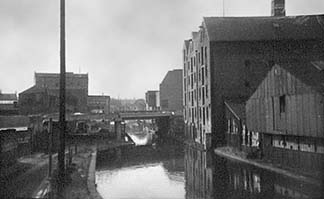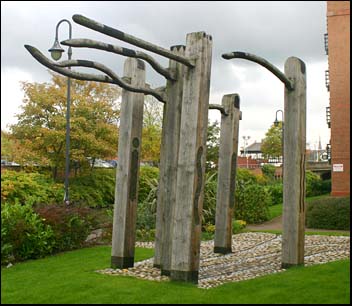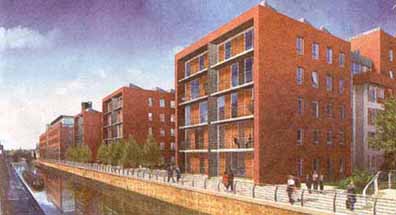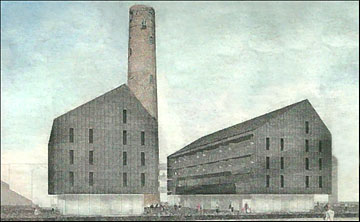  ere we see the canal a few yards further on from the above and about ten years later, sometime during the early 1960s. ere we see the canal a few yards further on from the above and about ten years later, sometime during the early 1960s.
The photograph was taken from the bridge connecting Seller Street with Egerton Street. The ironwork of this bridge deserves inspection should you pass by as it is deeply worn by the tow ropes of the great horses that pulled barges along the canal in former times.
The bridge we can see crossing the canal is the newly constructed St. Oswald's Way section of the Inner Ring Road. The large building on the right is the Griffiths Brother's mill which was later restored and converted into what is today the Mill Hotel. The sheds on the extreme right have since been replaced by the hotel's extension- and a further extension was a few years ago erected on the other side of the canal, linked to the hotel by a pedestrian bridge.
You can see some 1960s views of the canal looking in the other direction- and also a photograph of how it looks today- here - and here is another, rather romantic, contemporary view...
Moving down the towpath to the imposing Steam Mill, to its left may be seen a modern sheltered housing unit known as Steven Court. It stands on the site of Steven Street, described by former resident Joe Tranter as one of the poorest in the city: "The houses were standard two-up-two-down terraces, in a very narrow street with lots of people living in it. They struggled to get by and it was each for his own in order to survive."
In 1865, Steven Street boasted 42 of the 110 known common lodging houses in Chester. Over the door of each hung a small blackboard listing the name of the keeper and the number of lodgers allowed- a number rarely adhered to- and a set of 'rules of the house'. The Cheshire Observer reported that "in a small romm we found three truckle beds... each was taken by two occupants, for the three pence nightly charge by no means entitles a lodger to his own bed, much less his own room and he must overcome any qualms about sleeping next to a beggar, a convict or an unwashed tramp. The bedrooms are chiefly remarkable for their appearance of discomfort and destitution .."
One lodging house in the 1851 census for Steven Street recorded 18 Irish people living in one small terraced house! It is worth noting that the majority of these dilapidated properties were owned by rich citizens who almost certainly never ventured anywhere near them!
 Most of Boughton was a working-class area of factories using the canal which crossed the area and streets of mean housing where the local workers lived. On a day in June 1927, however, unexpected wealth came the way of the poor residents of Steven Street: the Boughton Gold Rush... Most of Boughton was a working-class area of factories using the canal which crossed the area and streets of mean housing where the local workers lived. On a day in June 1927, however, unexpected wealth came the way of the poor residents of Steven Street: the Boughton Gold Rush...
It seems that this local stretch of the Shropshire Union Canal had recently been drained in order to carry out maintainance. A boy from Steven Street, looking out for lost treasures from the tow path, found just that when he spotted a glint of gold. He didn't hesitate to jurnp into the mud and rubbish to fish out- a sovereign- worth about £50.00 of today's money.
But this is where he made his mistake- he climbed out and told everyone of his find. A crowd soon gathered and all jumped in and started frantically searching through the mire and soon found more sovereigns. The mud was about knee high but as it became churned up it seemed to get deeper and people were soon covered in it.
Initial opinion was that the canal was a robber's hiding place but the true explanation for the discovery soon came to light. An old lady by the name of Mrs Derrick had died in Steven Street some time before, and her relatives had cleared out the house of her belongings. They had taken the bed frame, but didn't fancy the look of the mattress, so like a lot of things in those days, it was dumped in the canal. What the unfortunate relatives had not realised was that she had kept her life savings- in sovereigns- in her mattress. Over time the mattress, under water, had rotted away and the sovereigns had spread around in the mud.
Our photograph of the event was one of several discovered by local historian Len Morgan in a barber's shop run by brothers Tom and Harry Toner near to the canal. He recalled, "I could always remember my dad telling me the story, but even when I had found the photos nobody seemed to have exactly the same story to tell me, so I set about searching for people who were actually there on the day itself.'
Mr Morgan successfully found six of the 'gold rush' participants, including a man named Jimmy Thompson, who appeared as a young boy in the photos and now lives in Blacon, and Julia Igo, whose mother had unwittingly thrown away a fortune when she disposed of the crucial mattress. He says: "Her mother had cared for Mrs Derrick, the old lady concerned, and had actually been told by the dying lady that she could have the mattress because it was 'valuable'. But instead she threw it in the canal and caused the commotion."
 This is how the 'Boughton Gold Rush' was described by a reporter from the Chester Chronicle, June 11th 1927: This is how the 'Boughton Gold Rush' was described by a reporter from the Chester Chronicle, June 11th 1927:
"Golden sovereigns, mummy- golden sovereigns! It's true, they're in the canal!
Three times- more than that, and more than three times three- a breathless little boy called out thus in Boughton on Tuesday noon, but he must have told them a score of times before he could make them understand.
Golden sovereigns in the bed of the canal! It was stunning news and at first it took some believing. But it didn't take these spectators half as long to bend round the corner of Steven Street and get over by the canal gate on to the portion of the canal which is being drained, where the first rich vein was struck. In the course of the first day quite a number of sovereigns, apparently, were unearthed by these poor prospectors who came armed with buckets and spades, sieves and trowels.
This pleasing creation stands in the gardens of the new apartments facing upon the canal. They resemble a series of outsized tillers in memory of the working barges that long passed this way- and the pleasure craft that continue to do so today.
In the humble homes of Steven Street- easily one of the humblest thoroughfares in the city- one can imagine the excitement. Golden sovereigns! Until Tuesday, Steven Street hardly knew what gold was. But they were all fabulously rich by Tuesday night- at least, so the late and unlucky prospectors said.
About the hour when a Chronicle reporter arrived, it had gone round that Steven Street dwellers had locked themselves in with their newly-acquired wealth. Many of them in Steven Street, it was freely stated, had acquired from the canal bed as much as 20 or 30 sovereigns each. Some of the pieces of gold were Queen Anne sovereigns, but those recovered were mostly of more recent reigns".
 Further big changes were announced in March 2004 concerning the environment of Chester's canal. Planning permission was granted for what is currently the car park of the Halifax Bank of Scotland (HBOS)- the large open area on the right hand side of this photograph- to be transformed into the bank's new regional headquarters together with 250-300 homes, including luxury penthouses and 25% (ha ha) 'affordable' housing units. There will also apparently be a public square and café bar. The bank's existing high-rise office building, Thistle House in nearby City Road, is to be converted into a 112-bed hotel. Further big changes were announced in March 2004 concerning the environment of Chester's canal. Planning permission was granted for what is currently the car park of the Halifax Bank of Scotland (HBOS)- the large open area on the right hand side of this photograph- to be transformed into the bank's new regional headquarters together with 250-300 homes, including luxury penthouses and 25% (ha ha) 'affordable' housing units. There will also apparently be a public square and café bar. The bank's existing high-rise office building, Thistle House in nearby City Road, is to be converted into a 112-bed hotel.
Considerable concern has been expressed by local authority traffic planners and some councillors regarding the likely increase in traffic on narrow local roads, especially the already horribly-congested Hoole Lane where children attending St. James' Junior School have long had to compete
with the 'foot on the accelerator, hand on the mobile' thrusting young banking community. A recent amalgamation with the neighbouring infant's school has led to even younger kids being forced to run the gauntlet- and ne'er a mention of any form of traffic calming during the entire debate.
Somehow the existing 1,381 car parking spaces at the bank will be increased (via a new multi-storey car park) by a mere 12 and some- as yet tenuous- form of 'travel plan' is said to be being put in place.
Local arbiters of taste in things architectural, the Chester Civic Trust, have panned the design of the proposed development, saying that though the scheme has been "substantially redesigned", the result remains "disappointing". We at the Chester Virtual Stroll have been known to occasionally criticise some of the Civic Trust's pronouncements- such as their views regarding the historic Electric Light Building at the 'Old Port' and the recently-demolished Police HQ- but, viewing the above 'artist's impression' of the charmless proposed new buildings, we find it difficult not to heartily agree with them.
May 2012: Over eight years have passed since the above was written with ne'er a sign of this particular canalside development but grander plans are afoot- a large new branch of Waitrose, a hotel and offices are soon due to be built on the sites of the decaying Boughton Retail Park and St. Paul's school and a vast new 'business district' is also planned to rise in the vicinity of the canal and railway station.
In early 2012, we also heard of a development proposal for for the historic Leadworks site itself by Liverpool-based 'regeneration specialists' Neptune Developments ("Developing Relationships, Value and Environments", whatever that may mean). Described by a spokesman for the Chester Civic Trust as "a horrific design.. a rock bottom plan of doubtful commercial viability", the huge apartment blocks were supposed to 'blend in' with their historic surroundings by the use of a cheerless grey lead-like cladding, even though the majority of surrounding buildings, including the Shot Tower itself, are of red brick.
 On the right you can see an 'artist's impression' of the blocks that appeared in the local press. Cheerless indeed, they appear more suited to battery hens than people. On the right you can see an 'artist's impression' of the blocks that appeared in the local press. Cheerless indeed, they appear more suited to battery hens than people.
The aspiring developers claimed that their scheme would allow for the long-term survival of the "more historic" parts of the Leadworks site and would prove to be a catalyst for the regeneration of the wider area but their plans nevertheless attracted considerable criticism from councillors and locals. Councillor Angela Claydon, for example, said that "it would be a tragedy for Chester" if the development went ahead.
But then, in June 2012, Neptune's applications for planning permission and listed building consent were dramatically withdrawn. But only briefly, as, upon re-submission, it outrageously sailed through, despite heart-felt objections from councillors and other concerned individuals and organisations, including the Chester Civic Trust, the Chester Archaeology Society and the Chester Canal Heritage Trust. The Civic Trust's John Herson, speaking for all three groups, called the plans "horrific" and "crude"- "It will produce a brutal and gloomy development that looms over the canalside. These flats will look like a prison".
Councillor Angela Claydon commented "It gives me the impression of a workhouse. It's better than an empty site but it's not the best it could be".
Councillor David Robinson: "The regeneration of the canal has has been a great success; residents and visitors are proud of the canal and marvel at the history and grandeur of the Leadworks. The view of the Shot Tower is really important in Chester and I believe that this scheme quashes it". Cllr Robinson said he feared the development would come to be considered a carbuncle in the same way the Salmon Leap flats on the River Dee and the vile Travelodge at the Fountains Roundabout now are. On the subject of which, he reminded the audience that the developer's Mann Island scheme on Liverpool's beautiful waterfront has been nominated for the Carbuncle Cup- an influential annual award for Britain's ugliest new buildings. As a son of that great city, this writer wholeheartedly agrees with him!
That, despite promises, this planning permission allows- with the support of English Heritage- for the demolition of some Grade-II listed buildings on the site and the punching of several holes within the base of the unique, listed Shot Tower itself to provide access to the flats, should prove to be no surprise to any betrayed caring local citizen. This is Chester after all, where philistinism happens as a matter of course. Watch this space for the depressing latest...
|